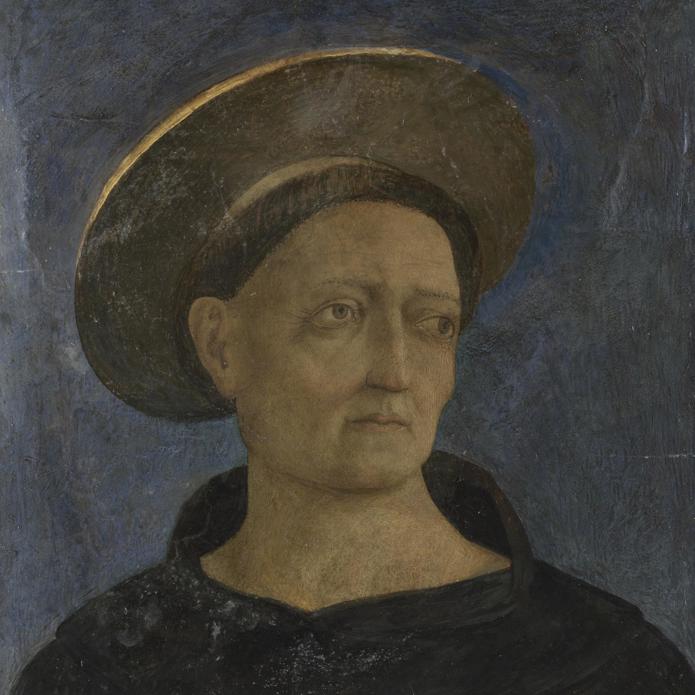Domenico Veneziano, 'Head of a Tonsured, Bearded Saint', about 1440-4
About the work
Overview
This is a fragment of a wall-painting made using the fresco technique (painting directly onto wet plaster). It comes from a ’street tabernacle‘ – an outdoor religious painting – that showed the Virgin and Child surrounded by two saints.
It is the head of one of the saints. We can’t identify him from his head alone, but his darkly coloured robes and tonsure (the central section of his hair is shaved – a sign of devotion among members of religious orders) suggest he was a friar, a follower of either Saint Benedict or Saint Augustine.
The tabernacle was painted on the first floor exterior wall of a house in Florence so that it would have been visible to passersby.
Key facts
Details
- Full title
- Head of a Tonsured, Bearded Saint
- Artist
- Domenico Veneziano
- Artist dates
- Active 1438, died 1461
- Part of the series
- Carnesecchi Tabernacle
- Date made
- About 1440-4
- Medium and support
- Fresco, transferred to terracotta tile
- Dimensions
- 45 × 35.5 cm
- Acquisition credit
- Bought, 1867
- Inventory number
- NG767
- Location
- Not on display
- Collection
- Main Collection
- Previous owners
- Frame
- 20th-century Frame
Provenance
Additional information
Text extracted from the ‘Provenance’ section of the catalogue entry in Dillian Gordon, ‘National Gallery Catalogues: The Fifteenth Century Italian Paintings’, vol. 1, London 2003; for further information, see the full catalogue entry.
Exhibition history
-
2014Building the Picture: Architecture in Italian Renaissance PaintingThe National Gallery (London)30 April 2014 - 21 September 2014
Bibliography
-
1951Davies, Martin, National Gallery Catalogues: The Earlier Italian Schools, London 1951
-
1986Davies, Martin, National Gallery Catalogues: The Earlier Italian Schools, revised edn, London 1986
-
2001
C. Baker and T. Henry, The National Gallery: Complete Illustrated Catalogue, London 2001
-
2003Gordon, Dillian, National Gallery Catalogues: The Fifteenth Century Italian Paintings, 1, London 2003
Frame
This twentieth-century frame, made at the Gallery, was inspired by fifteenth-century Venetian cushion frames. The architectural moulding is crafted from yellow pinewood and water-gilded.
The frame was designed for the opening of the National Gallery’s Sainsbury Wing in 1991.
About this record
If you know more about this work or have spotted an error, please contact us. Please note that exhibition histories are listed from 2009 onwards. Bibliographies may not be complete; more comprehensive information is available in the National Gallery Library.
Images
About the series: Carnesecchi Tabernacle

Overview
These three fragments painted in fresco (painting directly onto wet plaster) come from the outside of a house in Florence. They were removed in the mid-nineteenth century. They were part of a street tabernacle, a large outdoor altarpiece, painted high on a wall. It included a pair of full-length standing saints – only the heads remain – that would have surrounded the central image of the Virgin and Child enthroned.
This painting was on a house built by a member of the Carnesecchi family, who owned several properties in the area; the street was called the Canto de' Carnesecchi. This was a very visible spot on the route of religious processions in the city.



